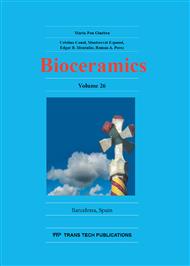p.306
p.315
p.321
p.326
p.332
p.341
p.345
p.351
p.357
Controlled Release of a Protein Using a Ceramic Carrier and Zinc Ions as a Novel Approach to the Treatment of Osteoporosis
Abstract:
The release property of osteoprotegerin (OPG) from hydroxyapatite / chondroitin sulphate (HAp/ChS) microparticles was described in this paper. The formulation was conducted by subsequent addition of zinc chloride solution into the mixture of HAp/ChS microparticles as a ceramic carrier and OPG solution. The release of OPG from the microparticles in PBS was positively correlated with soaking time without initial burst. The release rate of OPG was decreased with the increase of the amounts of zinc cation, which was not dependent of ChS wt% in the microparticles. The controlled release of OPG would provide the improvement of drug effect and the reduction of adverse effects. These findings reveal further investigation of the other antiresortive agents as a potential safer medication for osteoporosis.
Info:
Periodical:
Pages:
332-337
Citation:
Online since:
November 2014
Authors:
Price:
Сopyright:
© 2015 Trans Tech Publications Ltd. All Rights Reserved
Share:
Citation:


